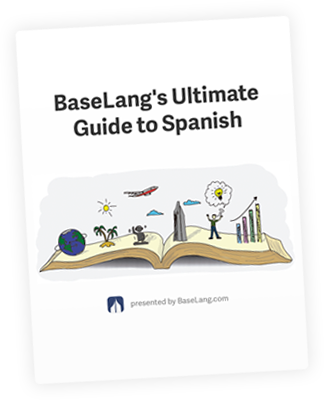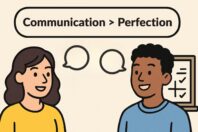How To Get Perfect Spanish Pronunciation

Get our free email course, Shortcut to Conversational.
Have conversations faster, understand people when they speak fast, and other tested tips to learn faster.
More infoI once ran a poll asking people what their #1 struggle with Spanish was, and a measly 4% said that Spanish pronunciation was their problem.
Meanwhile, 46% said understanding people when they talk fast.
What many people don’t realize is that these are two sides of the same coin.
Why? Because language is sound.
That’s ultimately what it is – a shared way of getting meaning out of certain sounds (sounds that form words and sentences).
And yet, there’s such a small focus on sound.
Most people don’t even think much about it.
You may be one of the many people who think that your pronunciation is “fine”. Maybe it is, but I bet for the vast majority of people reading this right now, your pronunciation isn’t “perfect”.
Pronunciation is one of the very first things you should learn, if not the first. When you have perfect pronunciation one of the obvious benefits is that you speak correctly.
But there are a few hidden benefits that I didn’t realize until after a few weeks:
- Your confidence is higher because you never have to repeat things to people. You could say something perfectly on paper, but if the pronunciation is wrong, you’ll likely have to repeat it – introducing doubt into your mind and hindering your confidence.
It’s also higher because when you know your pronunciation and accent are good, you suddenly are more apt to speak and have one less thing to worry about.
- You learn vocab faster. Good pronunciation means that you remember vocab words correctly, meaning you start recognizing and using the word in real life faster, which accelerates the process of learning a specific word.
- Listening comprehension goes up. When you have perfect pronunciation (the sound aspect), there are only two things that hold you back from understanding people when they talk fast: slurring and the words/ grammar not being second nature ie. you stall when thinking of the vocab
Pronunciation is more than fifty percent of this equation. If you want to improve your listening comprehension getting perfect pronunciation is the biggest win and a prerequisite for the other two factors to help.
- Less mental headache. Early on, speaking Spanish is a lot of mental work. If you train your mouth to handle the pronunciation part on autopilot, there’s a huge drop in mental work.
- People will switch back to English with you less (this is nearly impossible to avoid completely if you are in the US if you don’t look latino). The main reason people do this is because when you have a terrible accent, it’s sort of painful to listen to you, so they will switch to English if they speak it. It also makes people think your Spanish is bad – even if it isn’t.
Before we get into how to train your pronunciation, what is the difference between pronunciation and accent?
Let’s take an Australian and an American. They both have different accents in English, but neither have incorrect pronunciation.
An accent is just different pacing and sometimes different pronunciation of the same word or sentence.
So for instance, in Spanish, “y” and “ll” are pronounced in three main ways:
- like a “y” in English: llamas = “ya-mas” (Spain, parts of Latin America)
- like a “j” in English: llamas = “ja-mas” (most of Latin America)
- like a mix between “sh” and “j” in English: llamas = “shamas”(Argentina)
All of these are different accents, but correct pronunciation. This is an extreme example – other than this, the core sounds are all almost identical. So you can learn correct pronunciation and then pick an accent to tune how you pronounce certain things.
When in doubt, a neutral accent like in Colombia (inland, not by the coast) or Ecuador is your best bet.
On a similar note, using computer generated speech to learn, or trusting computer speech recognition to be correct, is a big no-no. They are almost never right, and never natural. Avoid them and get a real human to help, or at least a recording.
Related: Language Learning is Broken, And Software is Making it Worse
How To Train Spanish Pronunciation
The first step here is something that seems innocuous: learning the Spanish alphabet.
In fact, though simple, most of the people I’ve worked with on pronunciation find learning that the alphabet, and then being able to replicate the sounds perfectly, is one of the biggest and easiest wins.
Once you’ve nailed each individual syllable, you’ll start making full words.
After that, it’s off to the races with full sentences and music.
At each step, you’ll be doing a LOT of repetitions of each sound, word, or sentence. This is because your mouth is a muscle, and you need to build muscle memory so that perfect Spanish pronunciation comes out automatically. Muscle memory takes many repetitions to develop, but once it’s there, you’ll never have to worry about your pronunciation again.
Now, this part is a bit difficult to teach without sound (seeing as it’s about sound), so I created a massive free resource for you that has everything you need called “Sounds of Spanish”, which you’ll need to do the exercises I recommend.
Before we continue, click here to get access to that bonus.
You can read through this now without doing the exercises, but when you are ready to actually work on your pronunciation, make sure to click that and get the free resource, as you’ll need it.

Download the expanded guide to read later
This page gives you a great overview of the most important concepts and strategies, but for the full, expanded guide, click the button below:
Download Guide Now!Step 1: Learning The Spanish Alphabet
The first thing you’ll want to do is learn the Spanish alphabet. This covers almost every syllable you’ll use in Spanish. Here’s what to do to learn this.
It may seem like overkill, but it will actually save you a TON of time in the long run of constantly having to fix little issues.
For each syllable:
- Listen to the sound recording or watch the video (included for more difficult and important sounds)
- Practice making the sound until you think you have it perfect
- Record yourself saying it
- Compare your recording to one of a native. If it sounds the same to you, then…
- Have your teacher listen
- If they say it’s perfect (don’t take “close enough”), then practice the hell out of it. Sound is a muscle movement, and the more you practice it, the easier it will become to make that sound, which means you won’t slur, stumble, or stutter in the middle of a conversation.
- I recommend at least a hundred times for each vowel and two hundred for the two r’s. The rest of the sounds are used in English and you can get by with thirty or so at this stage.
A quick warning: if you skip the part where a native says you got it perfect, don’t do the repetitions. You will do nothing but be creating a muscle memory for the wrong sounds, which is counterproductive
Step 2: Practicing Full Spanish Words
OK, now we’re going to do the above process all over again with full words. I’ve hand-picked the words used in the resource to cover the most important sounds and progressively get harder.
For each word:
- Starting from the first word, listen to the sound recording
- Practice saying the word until you think you have it perfect
- Record yourself saying it
- Compare your recording to one of a native. If it sounds the same to you, then…
- Have your teacher listen
- If they say it’s perfect (don’t take “close enough”), then practice the hell out of it. Again – sound is a muscle movement, and the more you practice it, the easier it will become to make that sound, which means you won’t slur, stumble, or stutter in the middle of a conversation.
Once that’s done, it’s time for full sentences.
Step 3: Full Sentences
Here we go again, with the same process.
This time, it’s going to get a lot harder. I’m going to start with easier sentences, and then it will get faster and harder.
This step will help you a lot with understanding people when they talk fast. It’s going to be even more work, but by the end, you’ll have rocksolid pronunciation and will reap the benefits of it for the rest of your life.
For each sentence:
- Listen to the sentence a few times, and see if you can mimic it on your first try
- Practice saying the sentence until you think you have it perfect
- Record yourself saying it
- Compare your recording to one of a native. If it sounds the same to you, then…
- Have your teacher listen
- If they say it’s perfect (don’t take “close enough”), then practice the hell out of it. This is the most important step.
If you have just been reading along without doing the exercises, make sure to click here to get the Sounds of Spanish bonus and actually do all of this.
This entire process – from syllables to words to sentences – will take some time.
You can’t do it all in one day, and a week may even be a bit ambitious. There’s a reason I dedicated two hours a day to this for the first ten days or so of my own Spanish learning process.
But it’s worth the effort, or I wouldn’t be recommending you do it. Along the way, you can use the third-best tool for learning pronunciation (after these exercises and doing it live with your teacher): music.
The Magic Of Music
I’ll admit it.
I learned how the word “recuerdo” (I remember) is pronounced from J Balvin’s runaway reggaeton hit, “6 AM”.
In fact, I learned a LOT about pronunciation and the rhythm of the Spanish language from music. I happened to use primarily reggaeton (which is basically latin rap music), but you could use any music in Spanish, whether that’s salsa, bachata (which I also used), or something else.
There’s really no system here. Find a genre of music in Spanish that you like, download a bunch of your favorite songs (or an hour long mix from YouTube, like I did), and then listen to them over and over again, while singing along.
You will still get some benefit (other than the enjoyment of the music) from just listening, but for this to help your pronunciation, you need to sing along. If you don’t usually do that, go somewhere where you are alone, put in headphones so you don’t even hear yourself, and loosen up a little.
It’s a lot of fun, and it will help add some spice to the structured exercises.
Now, once you’ve sung along to some songs, and you’ve finished every syllable, word, and now sentence, all with your teacher’s stamp of “perfect” approval – you have perfect Spanish pronunciation.
This post was an excerpt from a 119-page book I wrote about the tactics and strategies I used to learn Spanish fast in my “Spanish in a Month” documentary.
If you want to replicate the success I had, then you can download the entire book, for free, right now.

Download the expanded guide to read later
This page gives you a great overview of the most important concepts and strategies, but for the full, expanded guide, click the button below:
Download Guide Now!


